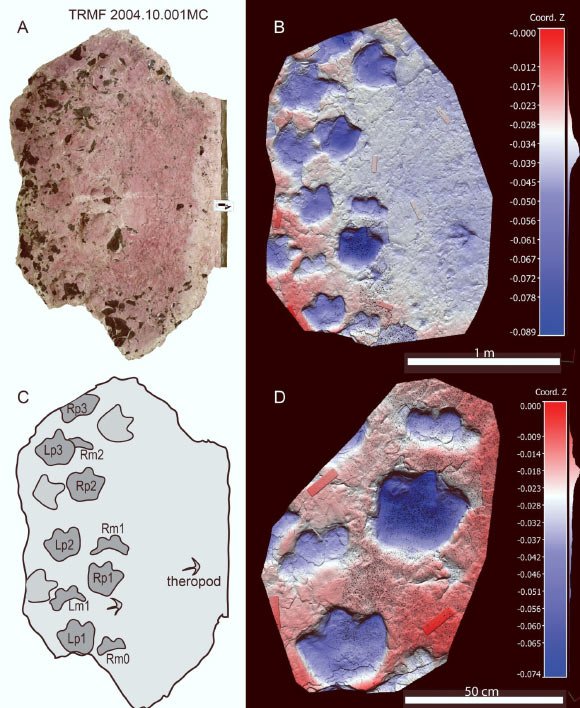Assigned to the new ichnospecies Ruopodosaurus clava, these dinosaur footprints found in northeastern British Columbia and northwestern Alberta confirm the presence of ankylosaurid ankylosaurs in the mid-Cretaceous period of North America.

Cast specimen of Ruopodosaurus clava from the Murray River, British Columbia, Canada. Image credit: Arbour et al., doi: 10.1080/02724634.2025.2451319.
“There are two main groups of ankylosaurs,” said Dr. Victoria Arbour, an evolutionary biologist and vertebrate paleontologist at Royal BC Museum and the University of Victoria, and her colleagues.
“Nodosaurid ankylosaurs have a flexible tail and four toes, while ankylosaurid ankylosaurs have a sledgehammer-like tail club, and only three toes on their feet.”
“Unlike the well-known ankylosaur ichnospecies Tetrapodosaurus borealis found across North America, which have four toes, these new tracks — named Ruopodosaurus clava — have only three, making them the first known examples of ankylosaurid ankylosaur footprints anywhere in the world.”
“Ruopodosaurus clava means the ‘tumbled-down lizard with a club/mace,’ referencing both the mountainous location in which these tracks were discovered and the distinctive tail clubs of these dinosaurs.”
While they don’t know exactly what the dinosaur that made Ruopodosaurus clava footprints looked like, the paleontologists know that it would have been about 5-6 m long, spiky and armored, and with a stiff tail or a full tail club.
“Ankylosaurs are my favorite group of dinosaurs to work on, so being able to identify new examples of these dinosaurs in British Columbia is really exciting for me,” Dr. Arbour said.
The newly-discovered Ruopodosaurus clava footprints date back to the mid-Cretaceous period, about 100 to 94 million years ago.
No bones from ankylosaurids have been found in North America from about 100 to 84 million years ago, leading to some speculation that ankylosaurids had disappeared from North America during this time.
These footprints show that tail-clubbed ankylosaurs were alive and well in North America during this gap in the skeletal fossil record.
The discovery also shows that the two main types of ankylosaurs — nodosaurids and ankylosaurids, including this new three-toed species — coexisted in the same region during this time.
“Ever since two young boys discovered an ankylosaur trackway close to Tumbler Ridge in the year 2000, ankylosaurs and Tumbler Ridge have been synonymous,” said Dr. Charles Helm, scientific advisor at the Tumbler Ridge Museum.
“It is really exciting to now know through this research that there are two types of ankylosaurs that called this region home, and that Ruopodosaurus clava has only been identified in this part of Canada.”
“This study also highlights how important the Peace Region of northeastern British Columbia is for understanding the evolution of dinosaurs in North America — there’s still lots more to be discovered,” Dr. Arbour added.
“This find gives us a new piece of the puzzle about the ancient creatures that once roamed what is now Canada.”
The discovery is reported in a paper in the Journal of Vertebrate Paleontology.
_____
Victoria M. Arbour et al. A new thyreophoran ichnotaxon from British Columbia, Canada confirms the presence of ankylosaurid dinosaurs in the mid Cretaceous of North America. Journal of Vertebrate Paleontology, published online April 14, 2025; doi: 10.1080/02724634.2025.2451319











